Edward Morrison’s Letter
In 1960 Hugh and Dick Bradley, owners of the Pelly River Ranch near Fort Selkirk, received a letter from an Edward Morrison of Cumberland, BC. He had read a magazine article about Pelly Farm, as he called it, and wanted to relate his memories of time he spent there before the First World War. I saw this letter many years ago and my main memory was of a photograph that came with it of the farm buildings taken in about 1915.
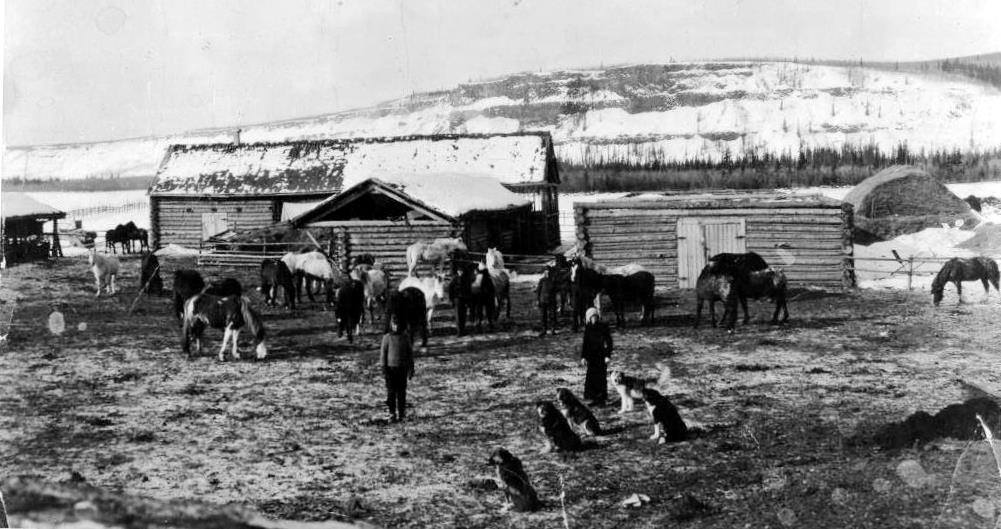
(Yukon Archives, Bradley Family fonds, Acc. 78/1, #1 – photo has been cropped)
Edward wrote about the farm’s operation when he worked there for a few summers for $3 per day plus board. He also said he spent the winters trapping at the head of the Selwyn River west of Fort Selkirk and in the McArthur Mountains northeast of Pelly Crossing.
Edward said he was “a bushed youngster in those days”, so took the occasional trip to Dawson City “for a glimpse of the high life”. He told about a day when he and Pete Oleson, one of the farm owners, saw a motorboat coming up the Pelly River toward them with four people in it, two of whom were women. He said the boat “was getting uncomfortably close and I lost my nerve” and he retreated to a haystack in the barn, where he found Pete already hiding out there. They decided to “face the music together” and went back out to the riverbank to greet the people.
Edward’s letter said nothing about how long he lived in the Yukon or that he had family who also had lived here. A new look at the letter and the photo a few years ago prompted me to see if he had descendants who might have additional information and photos from his time in the Yukon.
I was able to make contact with Edward’s granddaughter, Cherish Morrison, and then his daughter Carolyn Morrison in Washington. An exchange of information with them and some additional research began to reveal a multi-generational tale of life along the Yukon River basin from Carcross to Dawson City over several decades. Eventually two more of Edward Morrison’s grandchildren, Debbie Clark and Sue Morrison, entered the conversation with more information and photos.
The Morrison family’s Yukon life started in 1900 when Edward’s father, Angus Morrison Sr., arrived from Alberta. He was followed a few years later by his wife Anne and their children Edward, Angus Jr., and Alice. Angus Sr. and Edward had careers as telegraph linemen and operators, along with some trapping and mining activities, Anne was a cook and roadhouse keeper, and Angus Jr. was involved in mining. Physical evidence of their lives in the Yukon includes a building at Lower Laberge and a grave in Dawson.
Angus and Anne Morrison’s family story in the Yukon is made up of a patchwork of pieces of archival and family history information stitched together to tell it. This article will focus mostly on Anne, the matriarch, and her son Edward, a telegrapher and World War I veteran who started a family of his own in the Yukon.
As this Morrison family story is a fairly long one, it is organized in the following manner:
- Before the Yukon
- Into the Yukon, 1900 – 1906
- Mrs. Morrison of the Roadhouses, 1906 – ca. 1942
- Edward and his Lower Laberge Family, 1906 – ca. 1937
- Angus Sr. and Angus Jr.
- After the Yukon – Passings, the Family Lore, and Descendants’ Memories
- Angus Sr.
- Anne
- Edward
- Angus Jr.
- Final Words
Before the Yukon
Angus Morrison was a Métis man, born in 1859 in Manitoba in the Red River Settlement and one of 11 children of a Scottish man and his Cree wife. In 1881 Angus married Catherine Matheson, but two years later she died while giving birth to their daughter Catherine Matheson Morrison in Winnipeg.
Angus left his daughter in the care of his mother and headed west, participating in the 1885 Riel Rebellion in Saskatchewan as a scout. In 1889 he was in St. Albert, Alberta, just northwest of Edmonton, when he married Anne Grey, and in the 1891 census was listed as a farmer there.
Anne Grey was born in 1871 at Dunvegan, on the Peace River north of Grande Prairie, to a “Beaver Indian Woman” and a man whose lineage included Iroquois and Mohawk people from New York who came west around 1800 as independent fur traders. Anne had five siblings as well as 12 half-siblings from her father’s first marriage. Both of her parents died when she was relatively young.
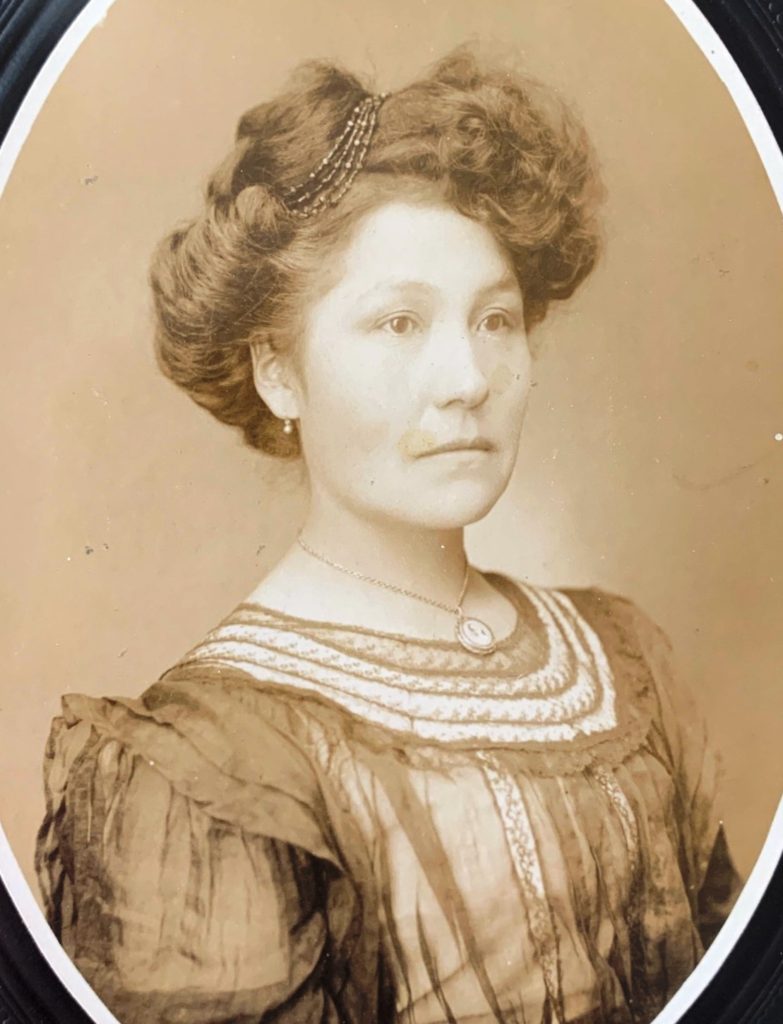
(Morrison Family collection)
Angus and Anne had five children, beginning with the birth of their first daughter, Mary Delphine, in 1889. The first son, named Samuel John, was born in 1892 but died at two months of age. In 1893 and 1895 came their second and third sons, Edward Grey and Wilfred Angus. Wilfred was known as Angus and is referred to here as Angus Jr. to avoid confusion with his father, Angus Sr. The last child of Angus Sr. and Anne was their second daughter, born in 1898 and named Alice Lydia.
By 1899, and perhaps earlier, Anne was participating in claims processes to apply for land and/or money she may have been eligible for through her indigenous ancestry. The results of these appear to have been largely unsuccessful because the lineage of her mother, who had been adopted, could not be proven.
At some point, Anne’s children began attending the Roman Catholic Youville residential school in St. Albert for Métis children. In the 1901 census all four children, even three-year old Alice, were listed as ‘boarders’ at the institution. The family’s life during these years in Alberta was not talked about with the generations that followed.
In 1900 Angus Sr. left his family in St. Albert and went to the Yukon, where he was noted in the 1901 census as being on board the steamboat Ora. His occupation was given as a logger, which in the Yukon context probably meant that he was cutting fuelwood for the steamboats. Anne was not yet 30 years old and left to raise her four children, then aged 11, 7, 4, and 2, on her own. Angus Sr.’s departure was likely the beginning of a general separation from Anne, even though they referred to each other as their spouse for the rest of their lives and she was noted as a ‘housewife’ in various records. Anne was a devout Catholic and divorce was not an option for her.
In about 1903 the portrait below was taken of the two eldest children, Edward and Mary Delphine. Not long after this, in January 1904, Mary Delphine died of tuberculosis at age 14. Her death led her brother Edward, who believed she had died of scarlet fever, to have a lifelong fear of the possibility of his children contracting scarlet fever. She was buried in the Roman Catholic Cemetery in St. Albert.
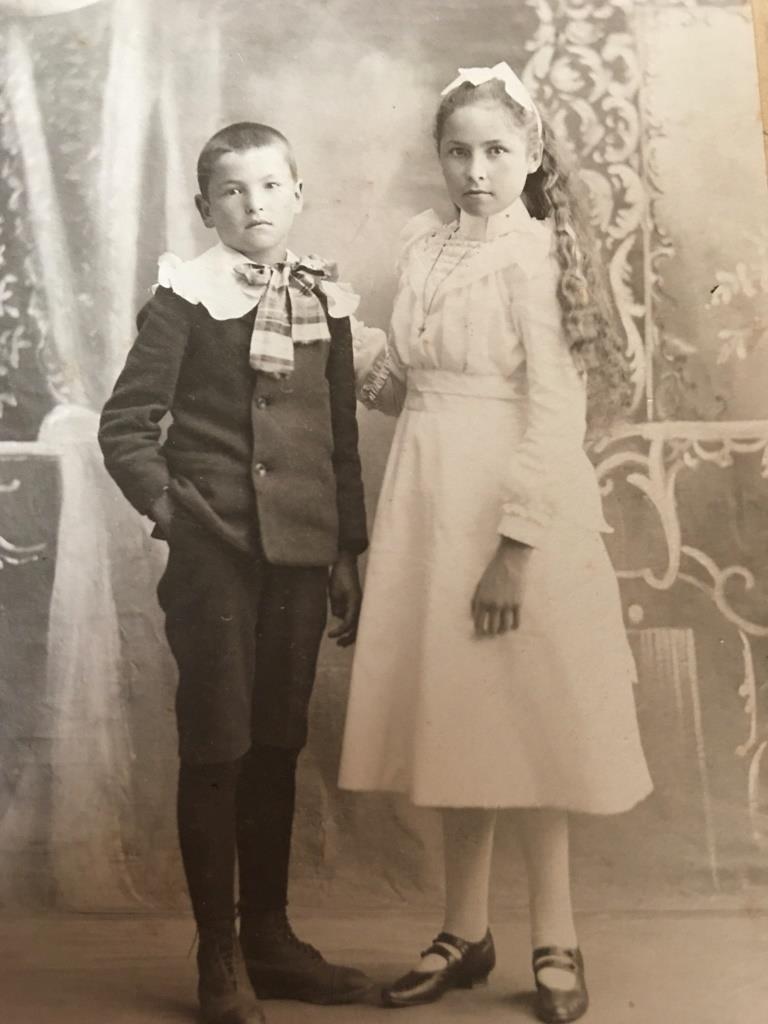
(Morrison Family collection)
Angus Sr. did not return from the Yukon upon Mary Delphine’s death, but did so the following year. He went to the residential school in St. Albert to visit 12-year old Edward, who did not know who he was.
A year or so later, the family’s circumstances initiated a change in the lives of Anne and her children when they also moved to the Yukon. It isn’t known for certain what factors led to this, but the descendants believe the residential school situation and Mary Delphine’s death, which likely resulted from her attendance there, was the prime motivation. Perhaps Angus Sr. described a way of life in the Yukon and opportunities there for the family that convinced Anne they should move north.
Into the Yukon, 1900-1906
In 1906 Anne Morrison and the children left for the Yukon, a journey that would have taken the better part of two weeks. It would have been by train from Edmonton to the coast at Vancouver or Prince Rupert, steamship to Skagway, the White Pass & Yukon Route railway to Whitehorse, and finally a 537-kilometer steamboat ride to Coffee Creek on the Yukon River, where Angus Sr. was working for the telegraph service. It was the beginning of a decades-long chapter in the lives of all but one of the family members.
The family started out at Coffee Creek and likely stayed together there or elsewhere for a period, since the children were aged 13, 11 and 8 when they arrived. There is only a little information about the children’s education during their early years in the Yukon. It is documented that at the ages of 16, Angus Jr. went to school in Vancouver in 1911-12 and his sister Alice attended school in Dawson in 1914-15.
At some point Anne began a career cooking in roadhouses, which would have provided her and the children a place to live while they were still with her. Edward eventually joined his father in working for the telegraph service for many years. Angus Jr.’s activities in the Yukon are less certain, but it seems that he was mostly involved in mining ventures.
During their years in the Yukon, the family members made occasional trips out of the Territory. From wherever they were living they would have travelled to Whitehorse on a steamboat in the summer or by the stage line (horse-drawn sleigh or wagon) in winter, then by the railway to Skagway, and on to Vancouver by steamship. Much of the Morrison family’s record of life in the Yukon is documented by the steamship passenger records of these trips, which contain information about their occupations, where they were living at the time, who their family contact in the Yukon was and where they were living, and their destination upon return.
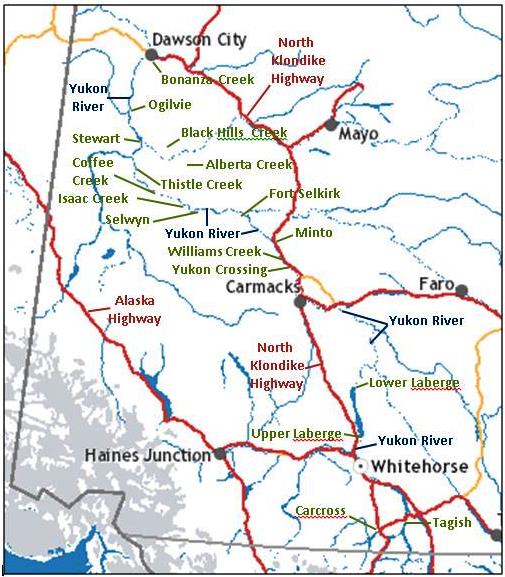
(GeoYukon mapping)
Mrs. Morrison of the Roadhouses, 1906 – 1930s
The documentation of Anne Morrison’s life as a roadhouse cook and operator is not complete, but a picture can be formed of it. Some roadhouses were called by their well-known operators’ names rather than by their location, such as “Clark’s” or “Mrs. Shaver’s”, and Anne appears to have earned that stature as well. Almost all of the writings that she is mentioned in refer to her as “Mrs. Morrison”, as if everyone would know who she is, and at the time likely many people did.
The family lore tells of Anne’s pride in her cooking and that she did it for pleasure, as much as for feeding people and making a living from it. She would taste-test and critique what she had made and add a bit of this or that, and said that she made the best bread in the Yukon. She had a pancake syrup recipe that she shared with Edward and swore him to secrecy, which he honored and so the recipe died with him.
The roadhouses that Anne was known to be associated with were mostly along the northern half of the Dawson-Whitehorse Overland Trail, a 530-kilometer winter road built in 1902 between the two communities. Most of these roadhouses operated in the winter only because in the summer the majority of people travelled on the steamboats, where meals and accommodation were provided.
Keeping a roadhouse in the winter was hard work, especially when it was very cold and the daylight hours were few. While the amount of traffic and numbers of customers varied by day as well as over the years, much of the same daily work had to be done regardless. Outside, firewood had to be cut and hauled in, water had to be hauled by bucket from a hole chopped in the river or creek ice, and snow shovelled when needed. Inside chores included food and bed preparation, general cleaning, keeping fires, lamps and lanterns going, and ordering and stocking supplies. Some roadhouses had a stableman to care for the horses that were kept there and he helped with some of these tasks, but a lot still fell on the shoulders of the cook/housekeeper.
Anne’s first such opportunity may have occurred sometime before 1910 at Williams Creek, on the Yukon River roughly halfway between Whitehorse and Dawson. This may not have been a true roadhouse to serve travellers, but rather a bunkhouse that housed miners and others associated with a nearby copper mining prospect. It was described as “a single story building with lots of rooms run by Mrs. Morrison”.
In 1910 Anne was noted as working at the Yukon Crossing roadhouse, 10 kilometers to the south of Williams Creek. By this time Edward was 17 and perhaps on his own, and Angus Jr. at 15 and Alice at 12 were probably living there with their mother.
Yukon Crossing is where the Overland Trail crossed the Yukon River and the roadhouse there was operated by or for the White Pass & Yukon Route company, which had the mail service contract between Whitehorse and Dawson. The primary function of the roadhouse was to accommodate drivers and passengers on the winter mail stage line, but it may also have operated in some summers if there were enough independent river travellers to justify keeping it open.
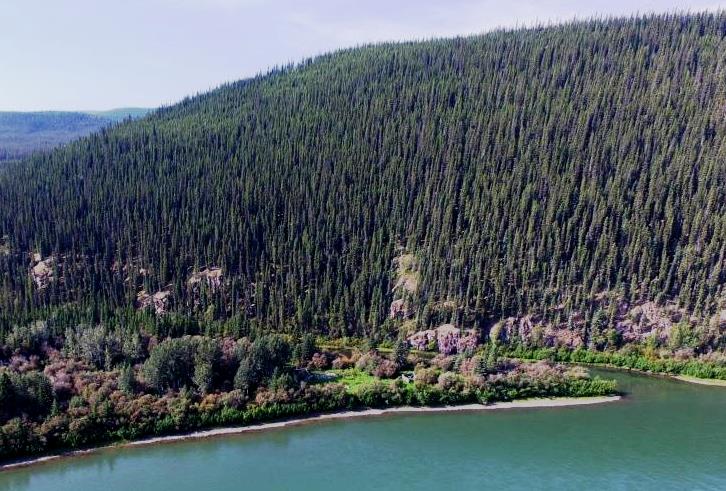
(Gord Allison photo)
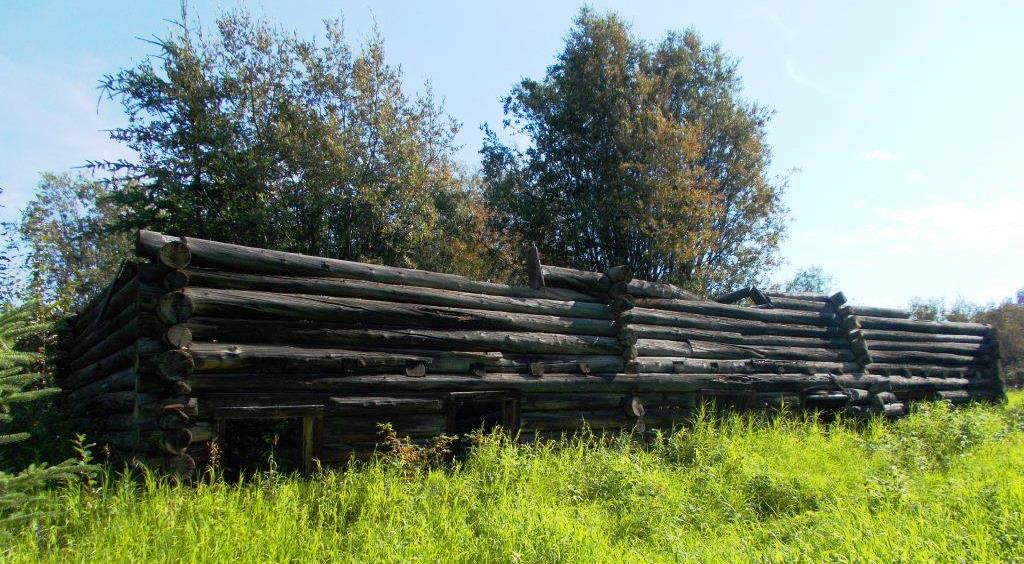
(Gord Allison photo)
In July 1912 Anne was recorded as travelling with 17-year old Angus Jr. on a steamship to the Yukon from New Westminster, where he had been attending school and living with his father’s brother. Their destination was Dawson, with Angus Sr. named as their contact there.
It was likely around this time that Anne was a cook on Bonanza Creek near Dawson, where the gold was discovered that started the Klondike Gold Rush. She worked there for the Guggenheims’ Yukon Gold Company dredging operation, which ended in 1912. A photo of Anne in cooking attire, standing beside a building that is possibly the cookhouse, has a notation on the back that she was a cook for 23 men there. She may have taken this job opportunity so that Alice, age 14 in 1912, could go to school in Dawson.
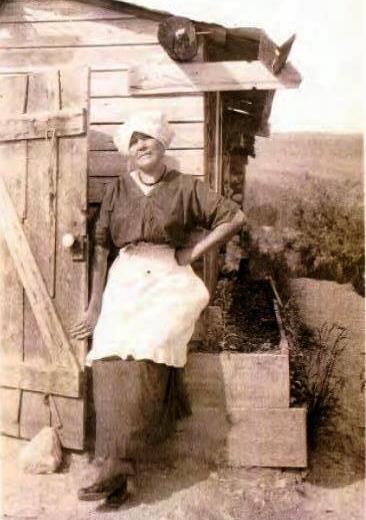
(Morrison Family collection)
Of all the roadhouses Anne worked at, she was associated mostly with the one at Minto, halfway between Whitehorse and Dawson. Minto was the only other roadhouse in addition to Yukon Crossing that was located on both the Yukon River and Overland Trail, and so it may have also ran in some summers in addition to its regular winter operation.
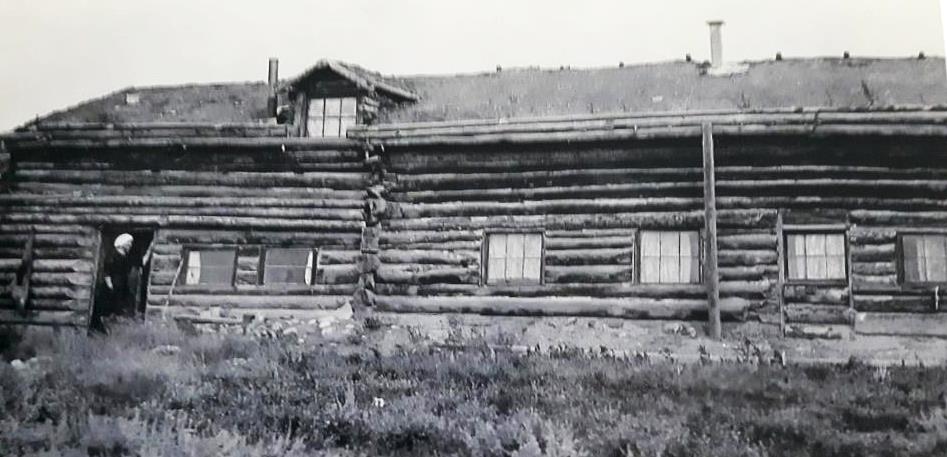
(Morrison Family collection)
It appears that Anne was at Minto in 1914, but the first certain record of her there is from 1915. Sadly, this is in connection with another tragedy in her life. Her daughter Alice, described by her family as attractive and vivacious and known for her singing voice, had attended St. Mary’s School in Dawson for the 1914-15 schoolyear. She then went to Minto to be with her mother, but later in the summer returned to Dawson to seek treatment at St. Mary’s Hospital for tuberculosis, a relatively common affliction at that time. In mid-October, on the last steamboat of the season, Alice came back to Minto for the final time.
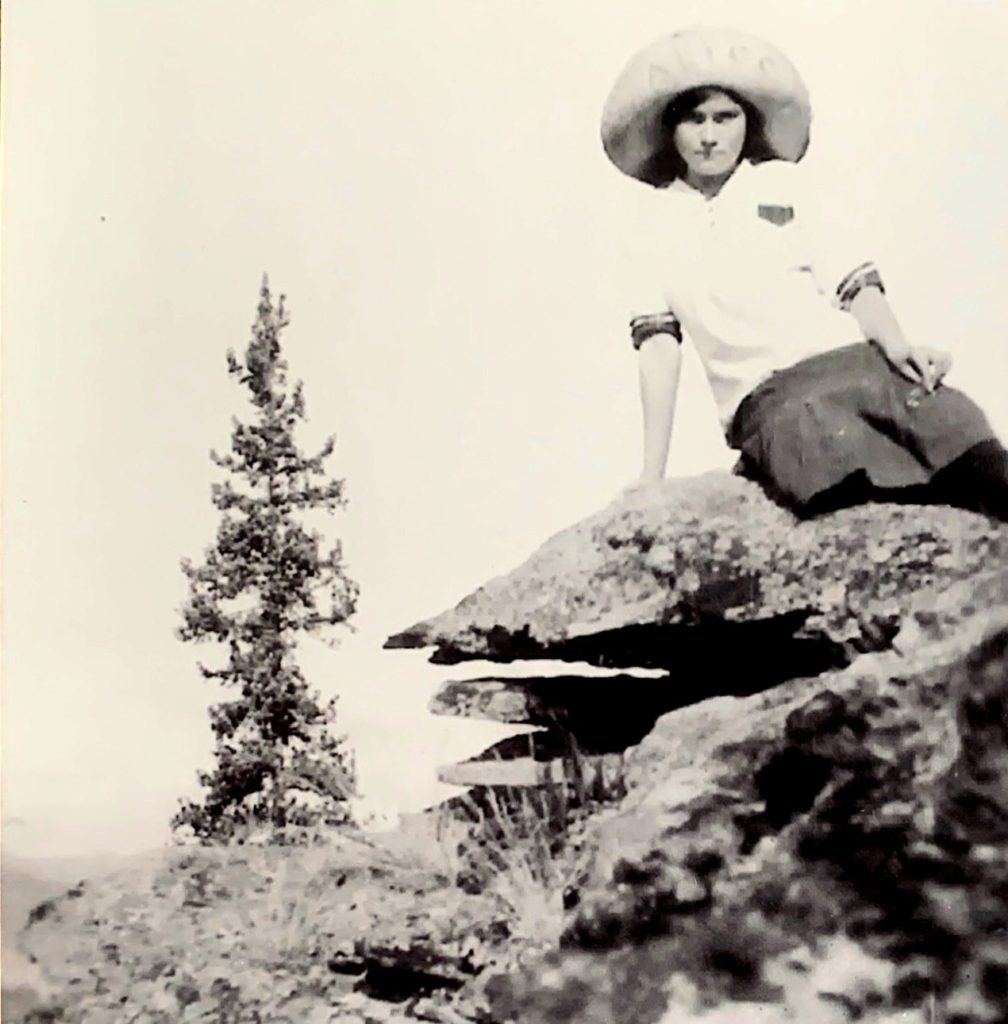
(Morrison Family collection)
According to the family lore, later in the winter Alice, who loved to dance as well as sing, got out of bed and went dancing, even though she was very ill. This most likely happened at the roadhouse when there were guests staying there, and perhaps was even initiated by her. Alice ended up collapsing, either while dancing or shortly afterwards, and her brother Edward set out by dog team to bring Angus Jr. back to Minto to be by her bedside. However, it was a long journey and the two brothers did not make it back to Minto before she passed away on February 11, just 11 days shy of her 18th birthday.
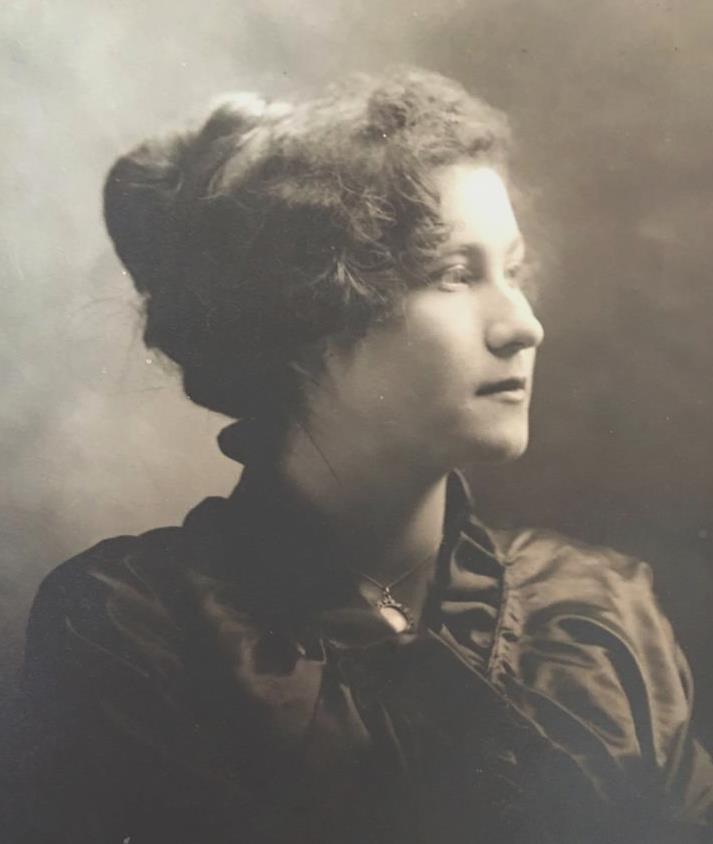
(Morrison Family collection)
Alice was said to have been deeply loved by her family, and Anne may have had to bear the moment alone when she lost her third child and only remaining daughter. Many decades later, Edward recounted the story of Alice’s passing to his young daughter Carolyn with tears in his eyes. Alice’s body was taken by the winter stage back to Dawson, where she was buried in the St. Mary’s Catholic Cemetery, the lone member of her family whose final resting place is in the Yukon.

(Owen MacKinnon photo)
After Alice’s death Anne left Minto and worked for at least the next two winter seasons (1916-17 and 1917-18) at the Alberta Creek roadhouse on the Scroggie Creek road, south of the Stewart River. She is also noted as working at the Black Hills Creek roadhouse, further along the road north of the Stewart River, but when that was is not known.
Interestingly, one of the records of Anne at Alberta Creek is a voters list for the 1917 federal election, where she was the only woman on a list of 14 people, most of the others being gold miners. Her name is marked by a “W” for ‘woman’, probably for statistics purposes, because it was the first election after women won the right to vote.
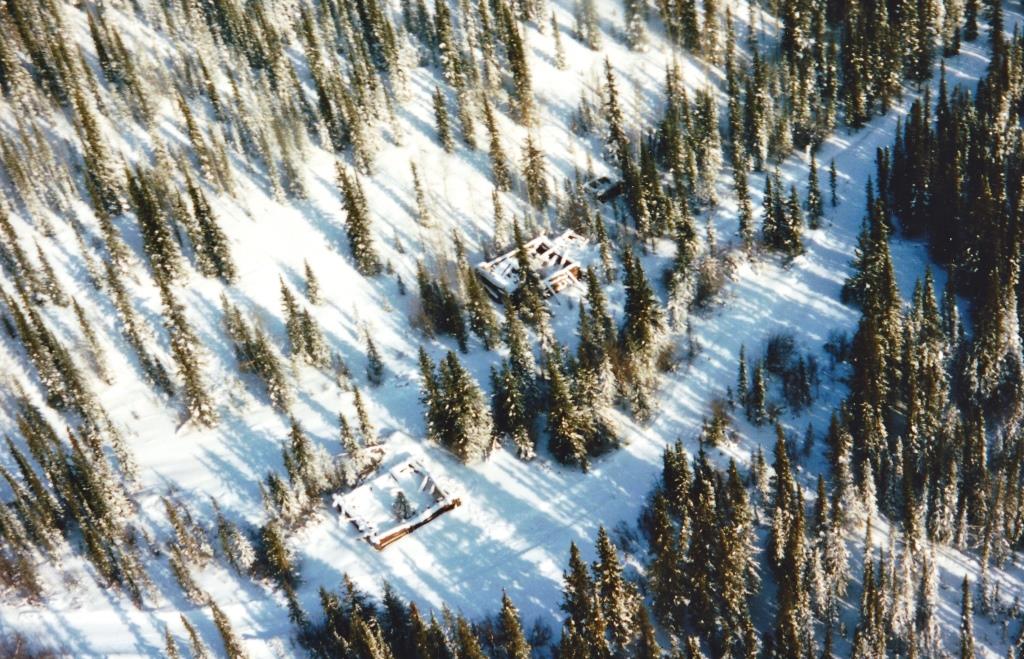
(Gord Allison photo)
When the roadhouses on the winter road such as Alberta Creek and Black Hills Creek were shut down for the season, most operators went elsewhere for the summer. In Anne’s case it appears that she usually went to Fort Selkirk, a community and steamboat stop on the Yukon River where she may have found summer employment.
World War I was on by this time and in the summer of 1916 Angus Jr. enlisted in Dawson and headed south for training, followed by Edward a year later. With their absence and Alice’s death, Anne’s only family remaining in the Yukon for the next two years, until her sons returned in the summer of 1919, was the husband she was separated from.
In January 1919 a newspaper article reported that “Mrs. Morrison” had recently relocated from the central Yukon River area to Carcross, a community in the southern Yukon, to work at the Caribou Hotel, which still exists and is a Yukon historic site. That summer she was reunited with her sons when they returned from the war, and also met a new family member in the form of Katherine, Edward’s new bride.
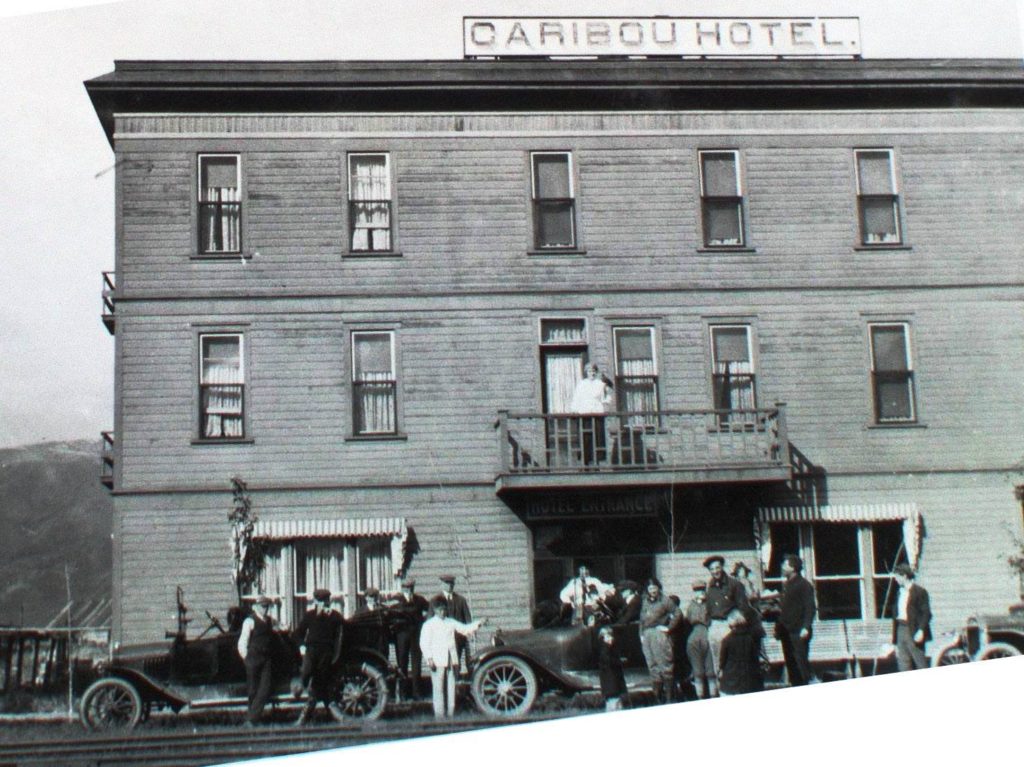
(Yukon Archives, Bud and Jeanne (Connolly) Harbottle fonds, Acc. 82/345, #6090 – photo has been cropped)
By 1921 all of the family except Angus Jr. were in Carcross, and there was a new addition, Edward and Katherine’s daughter, also named Katherine. Anne was living with Edward’s family and working as a chambermaid. Angus Sr. was also in Carcross working as a telegraph lineman, but was not living with the family.
By October of 1921, Anne had returned to the Minto roadhouse. Minto was somewhat of a focal point for both river and land traffic, and was becoming even busier by the time she arrived back there. A new road was being built from Minto to Mayo to provide better access to developing silver mines in that area, and a connection from it was soon made to Dawson as well.
Minto is in an attractive area and perhaps was in Anne’s heart by then because she applied to the government for a piece of land along the river about a mile upstream (south) of the roadhouse. It was beside a parcel of land that had been staked by her friend Mrs. Shaver, a well-known roadhouse keeper from Old Pelly Crossing. Anne wanted land for a garden, and perhaps both ladies may also have seen potential business opportunities at Minto with the new road developments. However, Anne did not undertake the necessary paperwork to further her application and did not get the land, nor did Mrs. Shaver get hers.
In late July of 1923 Anne went on an adventure when she undertook a solo trip on the Yukon River in a small boat from Minto to Dawson, a distance of 312 kilometers. The weather must have been hot because she departed at 3:30 AM and travelled only during the cool parts of the day. The trip took her five days and included stops along the way to visit friends. She was occasionally nervous about the strong current and stayed far out of the way of the wash from the steamboats when they passed by. In a newspaper article about her trip, Anne was described as “well known pioneer resident of Yukon, proprietress of the roadhouse at Minto”. The article can be viewed at Dawson Daily News – Google News Archive Search.
Another noteworthy event occurred in mid-March 1925, when the first known motorcycle to travel on the Overland Trail made a planned stop at Minto. It was driven by 22-year old Donovan Stewart and he had as a sidecar passenger his father “Sourdough Ray” Stewart, a veteran gold and silver miner in the Mayo area. Donovan had modified the motorcycle by putting runners (skis) on the front and sidecar wheels and wrapping a chain around the rear drive wheel.
Newspaper articles and a book about this adventure called Sourdough Ray make it clear that the two men planned a visit with “Mrs. Morrison”. From a roadhouse about 150 kilometers south of Minto, Donovan telephoned her in the morning to tell her they would be at Minto for lunch. She had already been listening in on the party line about their progress along the trail and said she was all ready for them.
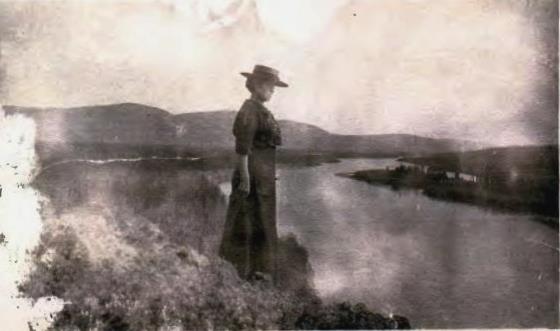
(Morrison Family collection)
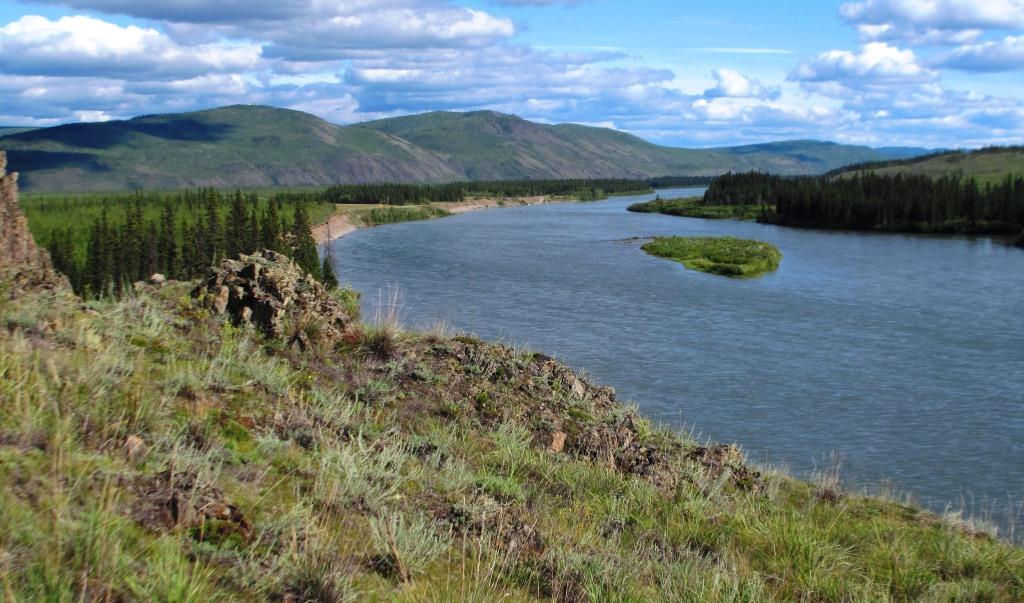
(Gord Allison photo)
Anne was still living at Minto in that summer of 1925 and had her four-year old granddaughter Katherine staying with her, likely to make it easier for Edward and Katherine Sr., who were preparing for a new life at Lower Laberge. After this, Anne’s trail in the Yukon is fairly spotty. In October 1929 she was living at Coffee Creek and in 1930 at Thistle Creek, down the Yukon River (north) from Minto, but what she was doing at those places is not known. In July 1930 Edward and Katherine made a trip outside the Yukon with their daughter but not their young sons, so by this time Anne may have had a new career in looking after grandchildren occasionally. In 1932 she was noted as living at an unspecified location along the river with her son Angus Jr.
There is a story within the Morrison family that Anne babysat well-known Canadian author Pierre Berton, who was born in Whitehorse in 1920. He spent his first year there before his family moved to Dawson and then eventually left the Yukon in 1932. It is not known when Anne could have babysat Pierre, but her record of movements would indicate it most likely to have been at Dawson in the latter half of the 1920s.
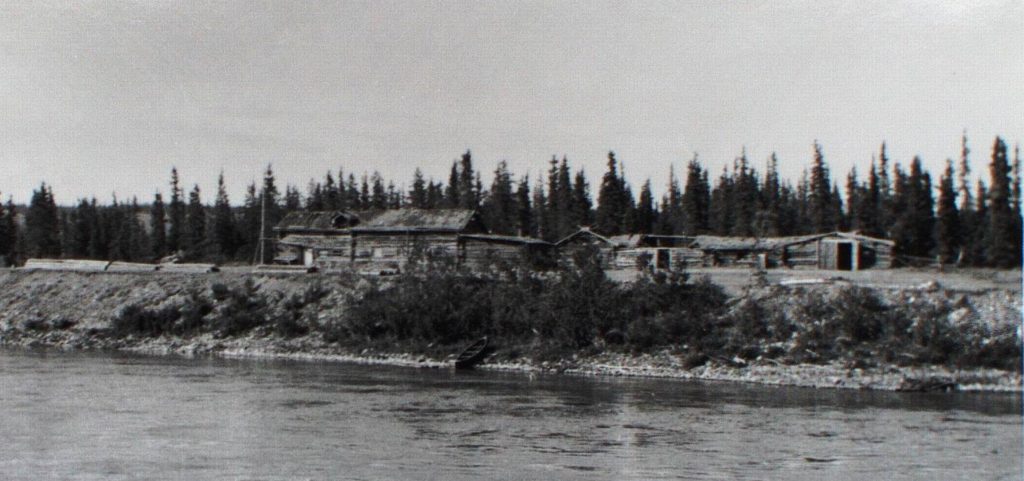
(Yukon Archives, Zimmerlee Fonds, Acc. 87/64, #57 – photo has been cropped)
By the time of the 1931 census, it appears that 60-year old Anne had ceased her years of hard work and settled into a quieter life living in Carmacks with her son Angus Jr. and his new wife Ruby. Anne was listed as having no occupation and both she and Angus Jr. declared their racial origin to be Indian and that they spoke Cree.
In 1934 Anne took a trip out of the Yukon and her destination on return was Carmacks, presumably meaning she was still living there. In 1936 she applied to the government for one acre of land along River Road about a mile west of downtown Carmacks and a year later she paid $10 for half the purchase price. However, there is no further information in the record and no house was built on the land until years after Anne left the Yukon. It appears that Carmacks was the last place she lived in the Yukon before leaving for Alberta in 1942. She was by then in her early 70s and had spent about 36 years in the Territory.
Edward and his Lower Laberge Family, 1906 – ca. 1937
Edward Morrison, the oldest of Angus Sr. and Anne’s surviving children, was 13 when the family moved to the Yukon in 1906. The first record of him after that is in the 1911 census, where he was listed as an 18-year old lodger with the Robert Lothrop family. They operated the roadhouse at Yukon Crossing where Edward’s mother had worked the year before, so perhaps he had stayed there to work for the Lothrops.
Sometime not long after that is when Edward began working at the Pelly Farm for a few summers for owners Frank Chapman and Peter Oleson. Edward’s last summer there appears to have been 1915, the date he gave for the photo of the farm buildings that he included with his letter to Dick and Hugh Bradley. In July 1916 he was noted as being a prospector, so was likely not at the farm.
The next year, in July of 1917, Edward enlisted in Vancouver with the 72nd Battalion (Seaforth Highlanders). By the following April he was with the 29th (Vancouver) Infantry Battalion and was on active service on the front lines in France. His battalion endured numerous shelling and gassing attacks and Edward saw many of his fellow soldiers killed or gassed in the trenches. He was shot in the leg, but was able to remain on duty with his injury, and was attending sniper school when the Armistice was declared. His battalion stayed in Germany until returning to England in April 1919. Edward’s service to his country in World War I was a matter of pride for him for the rest of his life and he observed every Remembrance Day.
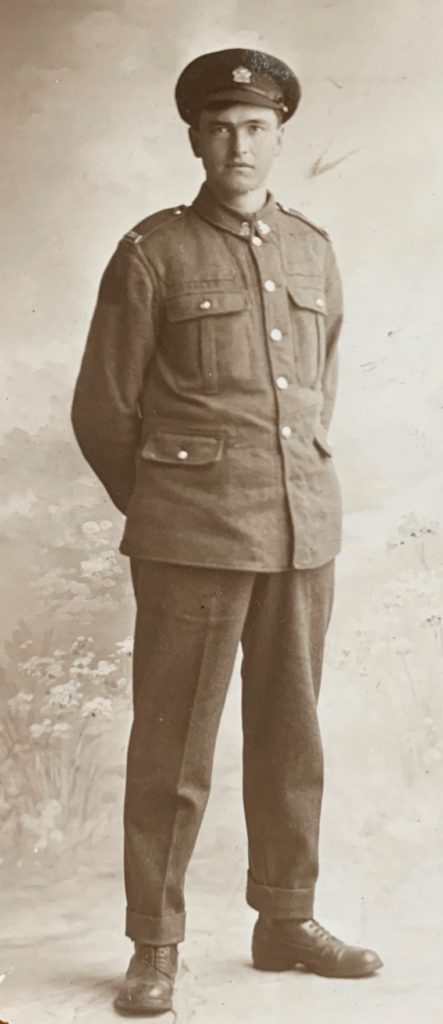
(Morrison Family collection)
Edward was demobilized from overseas service and arrived back in Canada in May 1919. On his return he met Katherine Davies at Montreal and they were married in June in Verdun, Quebec. Within 10 days they were on a steamship sailing northward from Vancouver to Skagway, with Dawson as their destination. Edward was listed as a miner, so perhaps had a job lined up there.
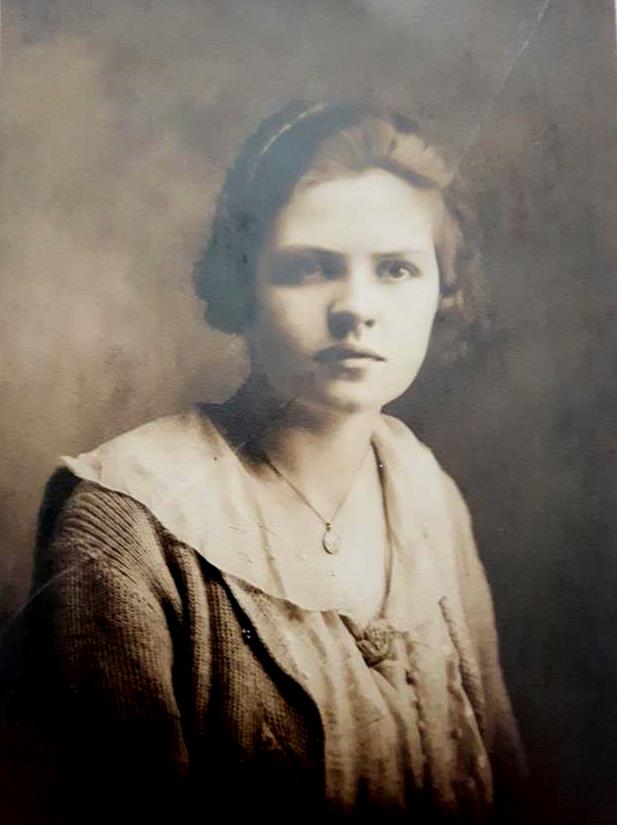
(Morrison Family collection)
In early 1921, Edward and Katherine were in Vancouver when their first child, Katherine Anne, was born. Later in the spring they travelled back north to Carcross, where Edward started his telegraph career, first as a lineman like his father, then as a telegraph operator. He and his family had Anne live with them in Carcross, and Angus Sr. was living in the community as well.
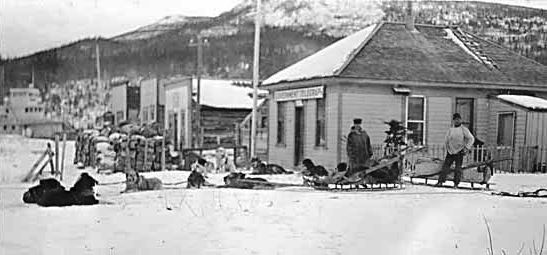
(Yukon Archives, Claude & Mary Tidd fonds, Acc. 77/19, #7783)
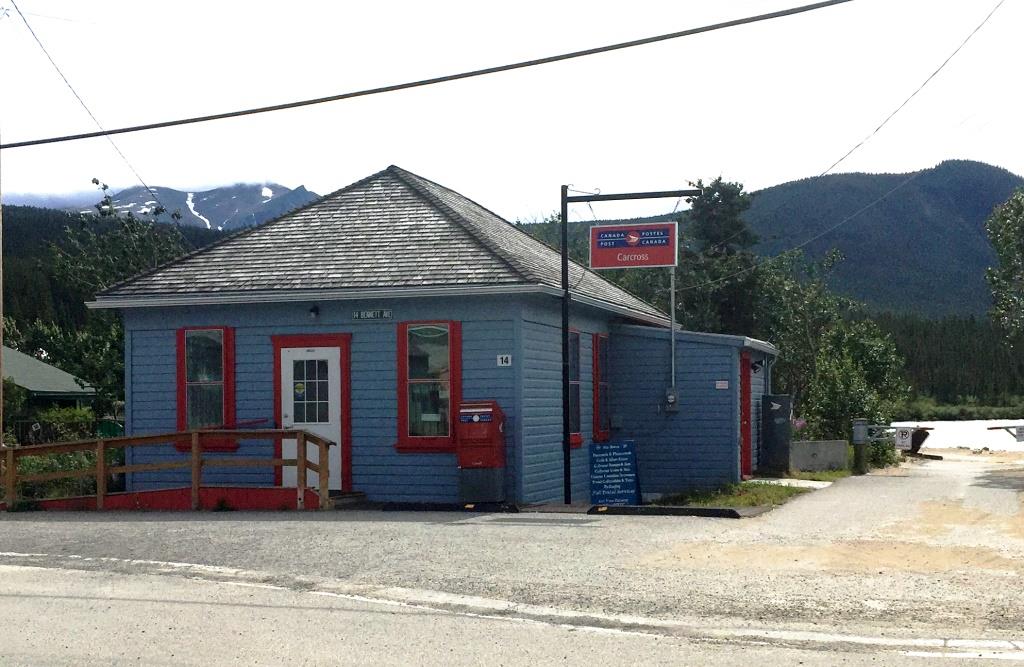
(Gord Allison photo)
Later in 1921 Edward was sent north to work for a short time at the Stewart River telegraph station, 108 river kilometers south of Dawson. The family has photos of this station and the Ogilvie station, the next one north along the river, so it is likely Edward worked there as well. He had his wife and daughter with him and they were still in the region in December 1922, when the first of their three sons, Edward Angus, was born in Dawson.
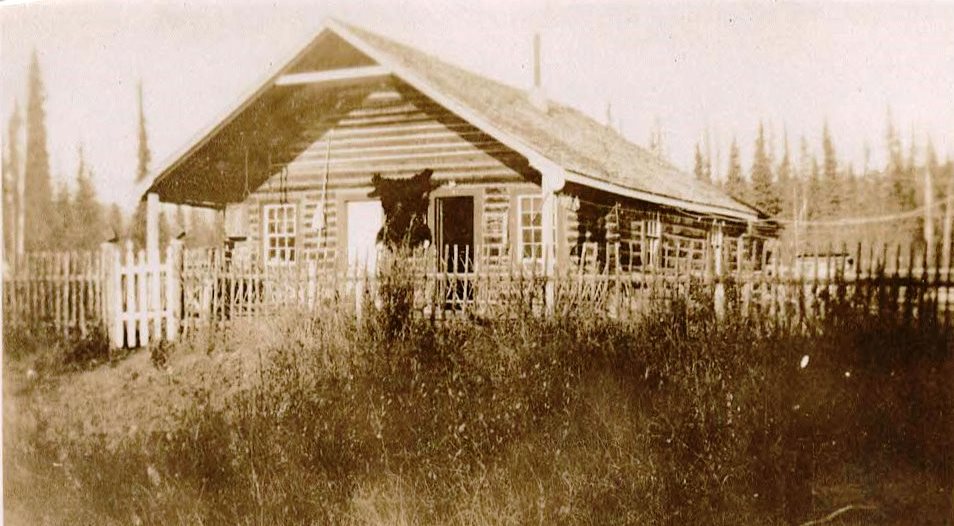
(Morrison Family collection)
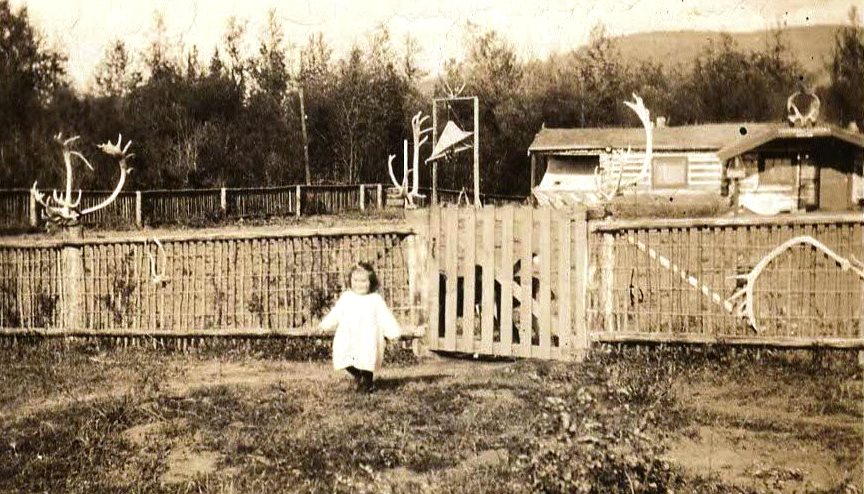
(Morrison Family collection)
In the summer of 1924 Edward and his family began a year out of the Yukon when he went to Iskut in northwestern British Columbia to be a telegraph operator there. His wife and two children joined him a month later and they stayed there until early the following summer. They moved back to the Yukon in May 1925, with the assistance of Angus Sr. who travelled down from the Yukon.
After their arrival in Whitehorse, Edward and his family travelled 88 kilometers north by steamboat to the north end of Lake Laberge, where Edward was to be the telegraph operator. This was the start of a 12-year life at Lower Laberge that included trapping and raising a family. It was the first home for two children who were born there, Gordon Grey in 1926 and Dennis John (“Frank”) in 1930.
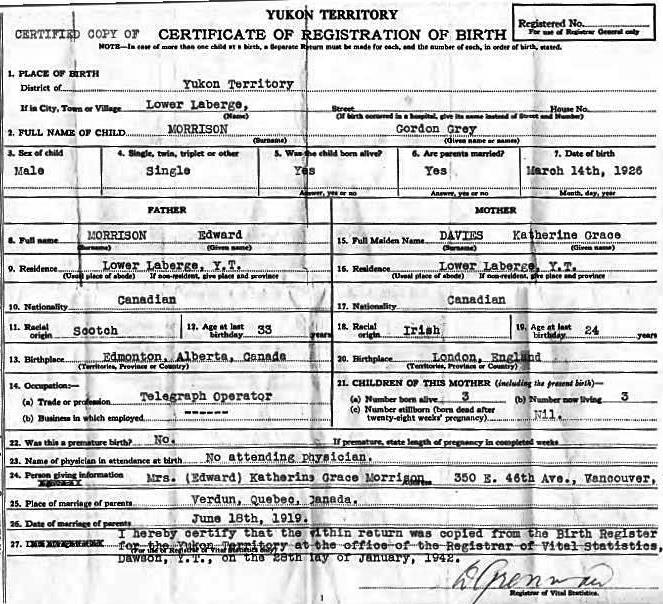
During the Morrison family’s years at Lower Laberge, the Yukon’s population was at its lowest after the decline of the Klondike gold rush, with just over 4,000 people. For half the year, generally from October to March, the family may have been the only people living at Lower Laberge and likely saw few others. There was a spike in activity during March and April when workers from Whitehorse travelled across the ice of the lake to prepare and load small steamboats that had been left to overwinter at Lower Laberge. When the river ice went out from there in late April or early May, transport of goods and people to Dawson on these boats could begin a few weeks ahead of the fleet wintering at Whitehorse that had to wait for Lake Laberge to become ice-free.
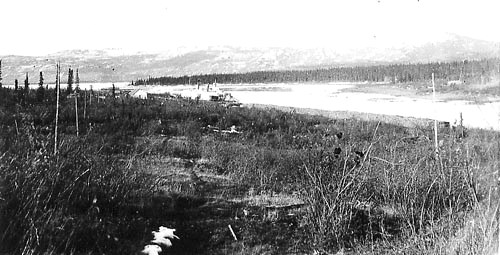
(Glenbow Archives, #NA-1663-45)
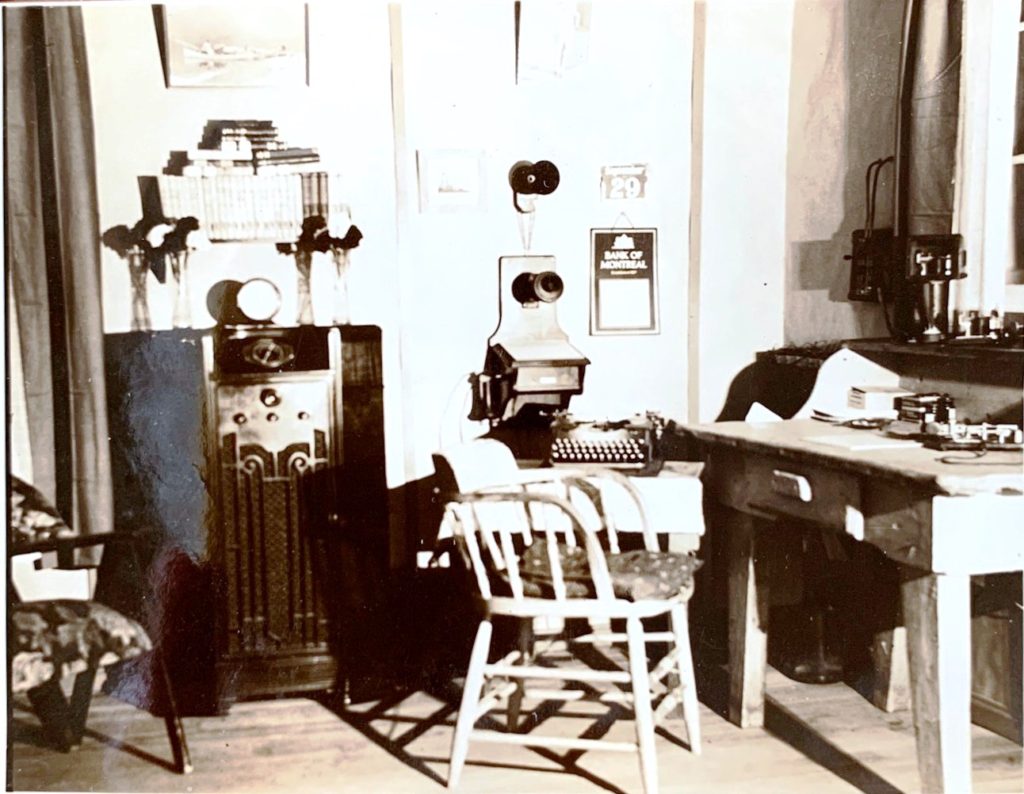
(Morrison Family collection)
At remote telegraph stations such as Lower Laberge, few messages originated from them, so the operators only had to report in the morning and do line repairs as necessary, since they were also responsible for the lineman duties. For any remaining time they could pursue other activities and many engaged in trapping, which Edward and Katherine both did.
In late June 1931 Hugh Bostock, in his first of many years as a Yukon geological surveyor, stopped at Lower Laberge where he observed that Edward and Katherine “with their children, they were a happy family”. He noted in his memoir Packhorse Tracks that Katherine ran a trapline of her own in the winter and had trapped the most beautiful silver fox he had ever seen.
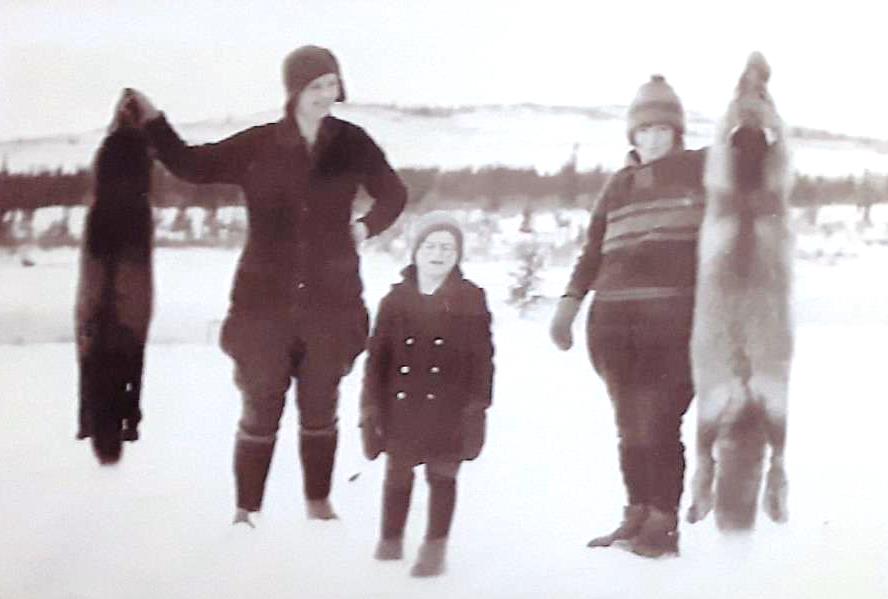
(Morrison Family collection)
Later that summer Bostock was at the Big Salmon telegraph station further down the Yukon River, where the operator’s wife told him that Katherine Morrison “was a very good trapper and everyone liked her”. She also offered her view that “Ed Morrison, though part Cree, was a good man”.
This expressed sentiment may have contributed, in part at least, to the information Edward provided to the 1931 census conducted that summer. The census noted that the racial origin of Edward and his children was Scotch and that their only language was English, in contrast to his mother and brother in Carmacks identifying their Indigenous heritage. Edward’s experience at residential school in Alberta led to him always being wary of his children being taken away to a similar institution in the Yukon.
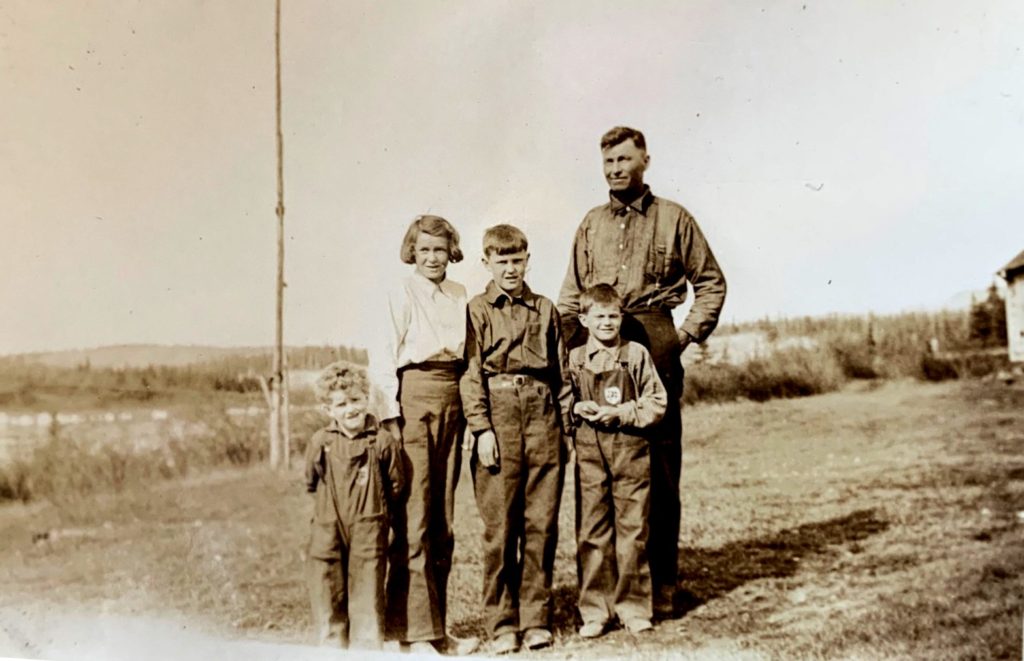
(Morrison Family collection)
In the fall of 1934 the family made a trip to Vancouver, evidently to take Katherine Anne to school there. Edward met with officials at the Government Telegraph Service head office, where it was arranged that he would construct a new telegraph building at Lower Laberge. That winter he went out and cut the logs for it, no doubt travelling by dog team because he had to go upwards of five miles to find logs of suitable quality. Later in the winter they were hauled in to the building site by a neighbor with a horse over a period of about 10 days.
The following summer, “at minimum of expense”, Edward built “a large well-constructed building” that was 19 feet by 48 feet in size. In his descendants’ photo collection, a photo of what was to them an unknown log building can be identified as one that is still standing at Lower Laberge. It is undoubtedly the one built by Edward and would have become the new telegraph station as well as the family’s residence. The building now is on Ta’an Kwach’an Council Settlement Land and is under private ownership.
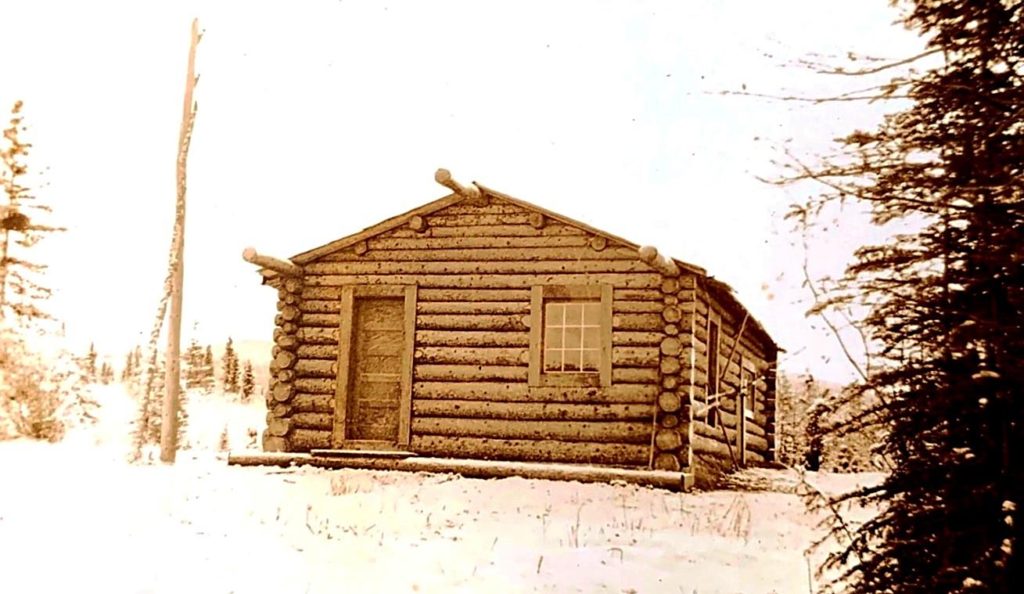
(Morrison Family collection)
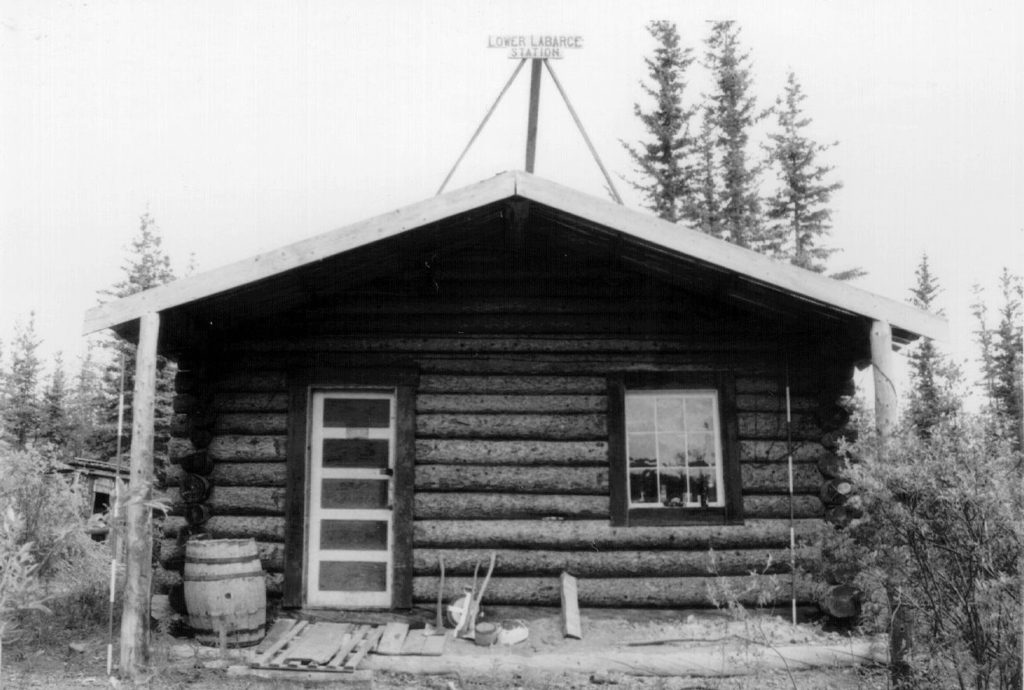
(Yukon Archives, Yukon Waterways Sites fonds, photo #06-17)
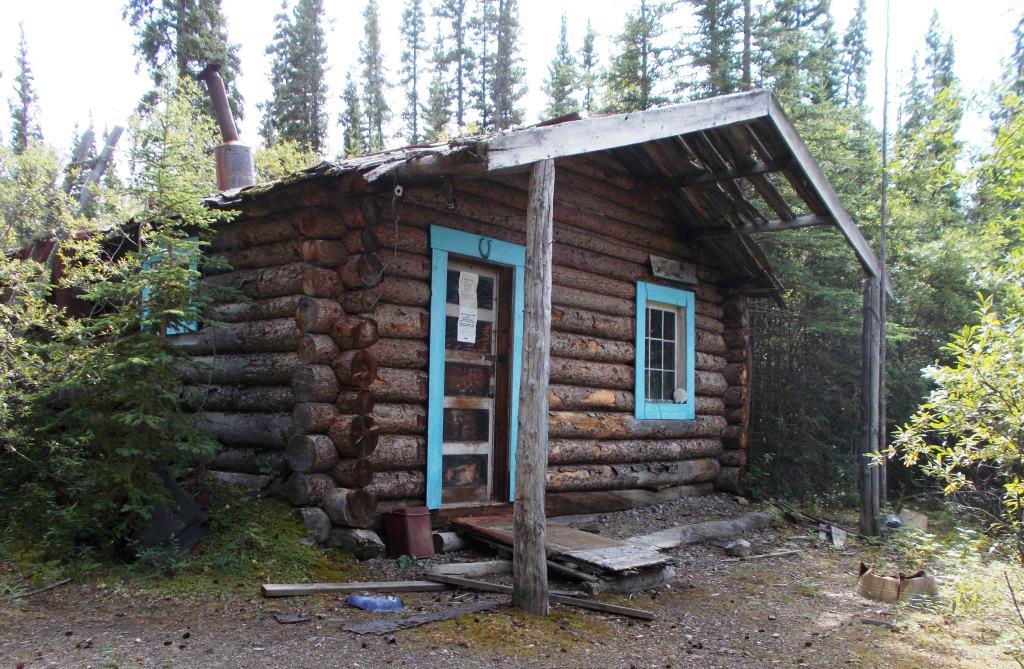
(Gord Allison photo)
In the summer of 1937, Edward and Katherine’s eldest son, Edward Jr., worked on a steamboat between Whitehorse and Dawson at the age of 14. After the family moved out of the Yukon, Edward Jr. returned for at least four summers to work on the steamboats. He came from Vancouver to work as a 16-year old laborer in 1939, as a deckhand in 1941, and a seaman in 1942 before serving with the Royal Canadian Navy in World War II. He returned to the Yukon River steamboats in 1947 as a ship’s officer, coming from Verdun, Quebec, where he perhaps was staying or visiting with his mother’s family.
Later in 1937 or possibly early 1938 Edward and Katherine and their children left Lower Laberge and moved to British Columbia. Edward had spent most of a 32-year period of his life in the Yukon and Katherine spent about 19 years.
Angus Sr. and Angus Jr.
Angus Morrison Sr. appears to have spent at least 18 years of his three and a half decades in the Yukon as a lineman with the telegraph service. This was mostly in very small places with only the telegraph station, an occasional police presence, and perhaps a roadhouse and some wood cutters in the vicinity. Beginning with Coffee Creek in 1906, other such known locations he was associated with were Yukon Crossing (1909), Ogilvie (1911), Isaac Creek (1916), Tagish (1918), and perhaps Selwyn (1912).
The telegraph system was an important means of communication in the Yukon in the first half of the 1900s, and Angus Sr.’s lineman job to maintain and repair the line along his designated section was also important. He had to be available 24/7 for any line problems that cut off communications, which usually happened during bad weather. It was physically demanding work in all sorts of adverse conditions, involving travel by foot (often on snowshoes), dog team, and small boat. His work was off the beaten track and involved camping out if needed, and he would have done much of it alone. Angus Sr. did this tough work until he was in his mid-60s.
After Tagish in the southern Yukon, Angus Sr. moved to the relative comfort of the nearby larger community of Carcross in 1918, where the rest of his family was soon living. That may have been where he ended his telegraph career, as he was noted as being a lineman there in 1924, but by the following year he was apparently a miner, his place of residence not known. His trail disappears after that and it seems that he may have left the Yukon by about 1934.
Angus Sr.’s trail next picks up in the 1931 census in the Fort Pitt, Saskatchewan area, where he along with his eight-year old grandson Edward from Lower Laberge, Yukon were enumerated in the household of his first daughter Catherine. Angus Sr. had left Catherine as a baby in Manitoba in care of his mother when he headed west to join the Northwest Rebellion in 1885. While he was in Saskatchewan and then Alberta, where he married Anne and started his second family, and then later the Yukon, Catherine was growing up in Manitoba. There she married James Brown in 1903 and by 1911 they had moved west to near Fort Pitt to homestead and started their own family. The 1931 census information and the photo below show that Angus Sr. maintained or revived his relationship with his first-born child Catherine, whom he likely had never seen much, if at all, after he headed west and left her as a baby in Manitoba decades previously.
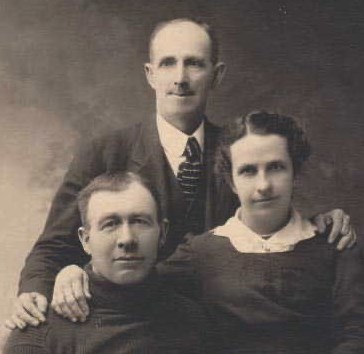
(Ancestry.ca, Taylor-White Family Tree)

(Morrison Family collection)
Angus Morrison Jr. started out his time in the Yukon at about 11 years of age. A few years later he attended school in 1911-12 in Vancouver, where he lived with his uncle Benjamin Morrison. In 1914, when he was still a teenager, he was at Coffee Creek with one of his parents, which one is not known.
There is not much information about Angus Jr.’s life in the Yukon, but one story was related by Emma Smythe, a roadhouse owner at Stewart Island, where the Stewart and Yukon Rivers join. In March 1914, her husband died and she got Angus Jr., at the age of 19, to come from Coffee Creek to take her to Dawson for the funeral by dog team, a three-day journey each way. On their return with the moon in the night sky, Angus Jr. asked Emma if she minded if he sang because “to be out on a night like this with a good dog team makes me want to”. The young man’s singing as well as the compassion he displayed in her time of grief was a significant enough memory for her that it appeared in a book years later about her life called Yukon Lady.
In May 1916 Angus Jr., then a miner, enlisted in Dawson with the Yukon Infantry Regiment and went to Victoria for training, followed by active service overseas, where he was promoted to corporal. Like his brother Edward, some of his pay was directed to be sent back home to his mother Anne. He returned from overseas service to the Yukon in June 1919 and appears to have gone to Dawson, but in October left there for Carcross, where all the other members of his family were then living.
By 1923 Angus Jr. left the Yukon and went to Montana, where he attended the School of Mines and worked in mining. He also married twice while there, and in 1930 returned to the Yukon with his second wife and was recorded as being a bookkeeper. The marriage, however, didn’t last and his wife moved back to the United States.
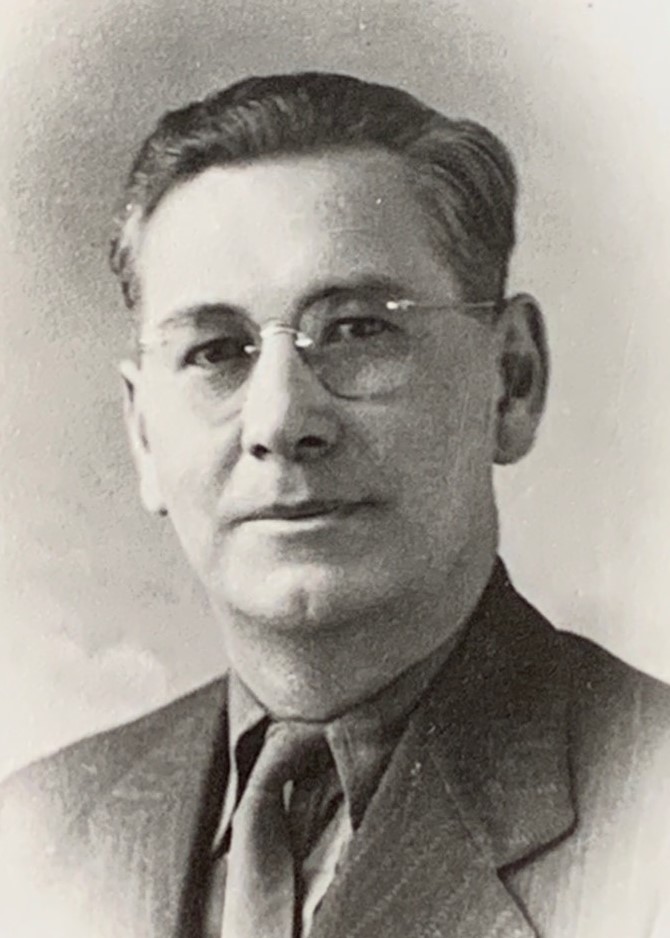
(Morrison Family collection)
Angus Jr. lived in Carmacks for some years where he was noted as being involved in mining and prospecting. He eventually moved to Whitehorse where he worked for the federal Department of Transport. He married there to Mildred Rowland, then in March 1961 they left the Yukon, the last of his family to do so after living here for about 45 of the previous 55 years.
About a year after Angus Jr. left the Yukon, he wrote a letter to the Bradleys at Pelly River Ranch, as his brother Edward had done a little more than a year before. He told them a bit about being around the farm in about 1914 or ’15, likely to visit Edward when he worked there, and coming across a spring with a strong smell and dead birds laying around it.
After the Yukon – Passings, Family Lore, and Descendants’ Memories
Angus Sr.
Angus Morrison Sr., the first of his family to go to the Yukon in 1900, was also the first to leave, sometime in the early 1930s. In 1934 he was in the Fort Pitt, Saskatchewan, area where his daughter Catherine Brown from his first marriage was living with her family. This is in the same area where he had participated in the Northwest Rebellion almost 50 years before.
By the following year Angus Sr. was in Surrey, BC living with Catherine’s daughter Ethel Hicks and her family. He stayed with them for three years until his passing on June 19, 1938 at the age of 79. He was buried in the Murrayville Cemetery there.
Angus Sr.’s history indicates that he abandoned much of his family responsibilities during his life, and in the family lore he is described as an absent and unreliable husband and father. This may explain that much of his background has been gleaned from recent research, rather than from family accounts. His Métis heritage, his first marriage including a daughter from it, and his involvement in the Riel rebellion all came as news to his descendants.
There are also suggestions, though, that Angus Sr. made some efforts to maintain his family relationships, as evidenced by photos with his grandchildren and lending assistance when needed, such as helping Edward and his young family move back to the Yukon after their year living in Iskut, BC. Angus Sr. also connected with his first family in Saskatchewan, including at least two visits there, and lived his final years in Surrey with his granddaughter and her family.
Anne
Anne Morrison settled in St. Albert, Alberta in 1942 after leaving the Yukon because of ill health. She returned to where she had started her family, but unfortunately she had none of them near her there, although she may have had extended family nearby. She eventually became a resident of the Youville Home for seniors and maintained contact with her family through frequent letter writing.
Anne remained a Yukoner at heart, as do many people who leave. Letters that she wrote to her family show that she stayed engaged with her Yukon friends for the rest of her life. On her Alberta death registration, the ‘Regular Residence of Deceased’ is recorded as Dawson City, YT, even though she had been gone from the Yukon for at least 15 years.
Anne did not see her sons often after she left the Yukon, but in 1956 she had a visit from both of them and also met Edward’s second wife Evelyn and their daughter Carolyn. Two years later, on July 17, 1958, Anne passed away at age 87 and was laid to rest in the St. Albert Catholic Cemetery, where her daughter Mary Delphine had been buried 54 years before.
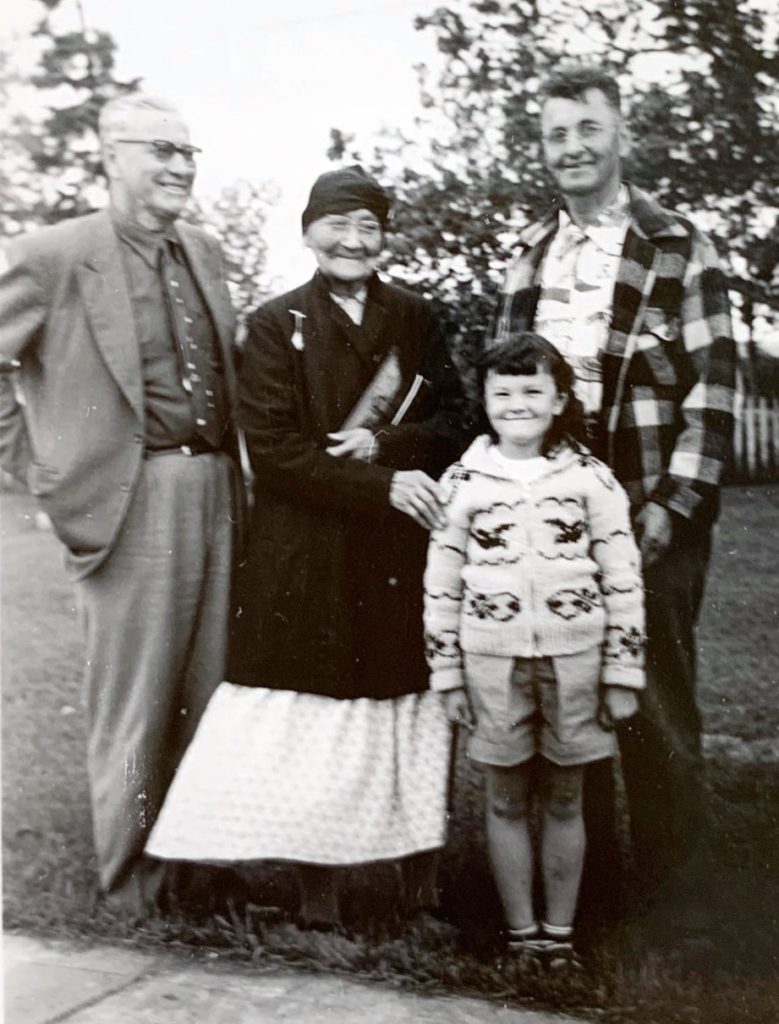
(Morrison Family collection)
Anne’s life and the way she lived it, with strength, dignity, and independence, is a source of pride for her descendants. She worked hard running roadhouses in fairly isolated places, mostly in the often tough conditions presented by Yukon winters. Early in her roadhouse career she did this while also raising her three children by herself. She showed her mettle in the solo boat journey of hundreds of kilometers on the Yukon River that she took from Minto to Dawson when in her 50s.
Anne took great care in her appearance, even climbing a hill in nice clothes in order to have a good picture of her taken overlooking “dear old Minto”, as she called it. Other photos show her creativity in rigging a camera to take pictures with her in them, probably because she was alone and knew that photos are usually more interesting with a person in them.
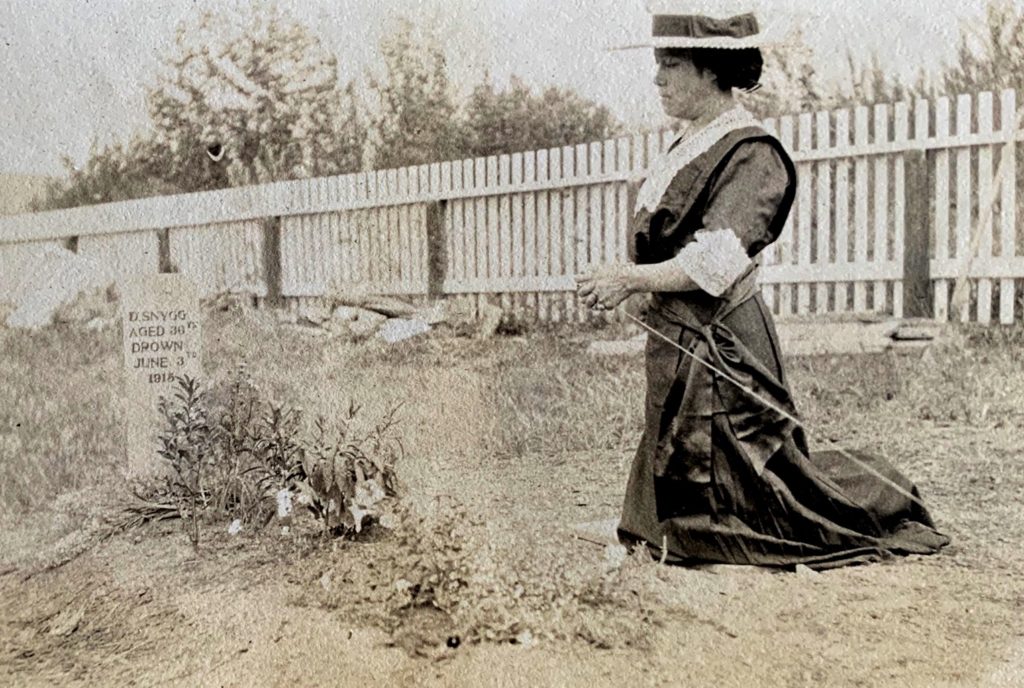
(Morrison Family collection)
Anne is regarded as a true matriarch by her family. She had to endure the deaths of three of her five children, including both her daughters when in their teens, but kept the rest of her family together as best she could. She raised her remaining two sons to be good men who served their country in wartime. She did much of this without the help and support of her husband.
Edward
At the time of his father’s death in 1938, Edward Morrison and his family were living in Quatsino on Vancouver Island, where he was a telegraph operator. By 1942 Edward and Katherine’s marriage had ended and he moved to the Tofino telegraph office. Katherine, who spent 19 years in the Yukon and raised four children with Edward there, went to Vancouver and later returned to Vancouver Island, passing away in Nanaimo on March 14, 1986.
Edward married Evelyn Wigmore in 1949 and the following year, when he was 57, their daughter Carolyn was born. He retired from the telegraph service in 1954 and became the primary caregiver for his young daughter while Evelyn was working as a nurse. In 1963 the family was living in Cumberland, BC, and planning a trip to the Yukon the following summer. Edward was building a travel trailer for the trip, but just after Christmas he suffered a heart attack and went into the hospital, where he remained until his passing a month later on January 26, 1964 at age 71. He was buried in the Cumberland Cemetery.
There are many memories of Edward, particularly by his daughter Carolyn who was very close to him from her birth to his passing. She describes him as a disciplinarian with a quick temper, but at the same time loving and kind-hearted with a good sense of humor. He was generally shy and quiet, and modest about any of his accomplishments, such as being able to play the violin but would not do so in front of other people because it drew attention to him.
One of the strongest lessons that Carolyn learned from her father, both by his words and his actions, was to never look down upon another person or to think you are better than they are. When she was a few months old, her parents were given a letter for her from a doctor at the Tofino Hospital to wish her a happy life. He expressed positive attributes of her parents and encouraged Carolyn to “partake of your father’s kindly disposition to humanity”.
Edward’s life in the Yukon from age 13 to 45 naturally shaped the man he would be. It required him to be very self-sufficient and even in later years living in BC he would hunt, fish and garden to provide for his family. He made a bow and arrows and a slingshot for Carolyn and taught her to shoot a shotgun. He kept busy at carpentry and cooking and even took up knitting. His building of a trailer for the family’s planned trip to the Yukon showed his do-it-yourself character. He loved the outdoors and said that he wished he could die under a tree.
Edward was a ‘meat and potatoes’ man who kept a can of bacon drippings on the stove for cooking with and put sugar on his lettuce. He was drawn to ‘salt of the earth’ type of people like himself and formed warm friendships with many of them. After his passing, Carolyn and her mother Evelyn learned from such people about the things Edward had taught them and how much he had meant to them.
Edward was always very protective of Carolyn and worried a lot about her in his final days, and would try to get out of his hospital bed to find her. When she visited him a few hours before he died, he told her that he was going to get better because he had a little girl at home who was depending on him. After his death, his brother Angus Jr. said that he had once heard someone compliment Edward on his children, to which Edward replied that anything he could do for his children is what they deserved.
Angus Jr.
Angus Morrison Jr. remained in the Yukon for nearly 20 years after the other members of his family had departed. He and Mildred moved in 1961 to Edmonton, where he passed away on December 16, 1970 at the age of 75. He was buried in a military grave in the Field of Honor at St. Joachims Cemetery in Edmonton.
Not as much is remembered by the family about Angus Jr., who did not have children of his own. While Carolyn’s father Edward was relatively quiet and shy, she described her Uncle Angus Jr. as much more outgoing. He expressed his view that the family should be proud of their indigenous heritage, a subject that Edward did not talk about much. Angus Jr.’s marriage to Mildred, who the family very much liked, was good for him and helped him to develop a closer relationship with the rest of the family in his later years.
Final Words
This Morrison family article was an unintended one. It started from researching a different topic in the Yukon Archives and rediscovering Edward Morrison’s letter that I had seen many years before. Little did I know that initiating a conversation with his descendants would open the doors to an appealing Yukon family story as well as material of wider Yukon historical interest.
Cherish Morrison, Edward’s granddaughter, was working on her family history and learning about her Canadian indigenous roots when I contacted her. She and her mother Carolyn were aware that their family had been in the Yukon, but they knew relatively little about the context and details of it. They were moved to see Edward’s letter, which they hadn’t known about, and said they had photos and information about their family’s Yukon life. So began a mutual exchange.
At this same time a family friend of the Morrisons, Stephanie Warner, was researching and writing a biography of Edward and his family on Vancouver Island for a story that appears on the Tofino Museum’s website (‘Mr’ Ed Morrison and family (tofinomuseum.com). Her work in that endeavor, particularly the preparation of a family history timeline and a summary of Edward’s military history, was very well done and helpful for this article.
When Carolyn began to share her material and her family knowledge, what emerged was a decades-long story of an indigenous prairie family coming to the Yukon to make a new life. She gave me permission to use what she had sent to help tell this story. This was later bolstered by photos and information provided by two more of Edward’s granddaughters, Debbie Clark and Sue Morrison.
This article is not the end of what Edward Morrison and his descendants sent back to the Yukon. Their photos and information combined with additional research can help to tell other related Yukon history stories. The letter Edward sent more than 60 years ago to Hugh and Dick Bradley at Pelly River Ranch turned out to be an unexpected gift.
Updated June 11, 2021
Updated October 2, 2023
Fabulous Gord
So enjoyed the story
Boyd
Thanks very much, Boyd, always appreciate the feedback.
Wonderful story. The life and hardships of these astonishing individuals should be forever remembered
I agree, Rob. Thanks very much for taking the time to comment.
This was a heart-warming and interesting account, Gord, of a remarkableYukon family. Thank you for sharing it.
Alister
Thank you, Alister. Good to hear from you.
Thank you for the many hours of research, writing and exploring that you’ve put into sharing our family’s story. We are all so proud of their hard work, tenacity, courage and creativity. My grandfather Edward and Great Grandmother Anne would probably have been rather astonished that their Yukon life would be documented so many years later in such an interesting account. Thank you, again, Gord for filling in many gaps for our family regarding their journey.
It has been my pleasure, Cherish. It wouldn’t have happened without your family being willing to share your photos and information. Edward and Anne were the sort of people that this blog is all about. Good luck with your further research into your family history.
William Morrison, a Scotsman, sometime after the amalgamation in 1821 of HBC and North West Co. (Fort William, Lake Superior) brought his Indian “wife” with him “back to Canada” where they lived near Berthier, Lower Canada. This may be linked to Angus.
Another wonderful Yukon story, Gord, that ties together the various types of employment and vast area traveled to maintain some cash income for highly adventurous pioneers who came north.
Thank you, Lew, glad you enjoyed the story. I will pass on your suggestion about William Morrison. The family is continuing to try to discover more of their roots within Canada and outside it. I think the Morrison connection in Scotland is from the Isle of Lewis in the Outer Hebrides.
Thank you again, Gord, for your interest in our family and the wonderful blog post based on a lot of research on your part. We now know more about the Morrison family’s Yukon years that we ever did before. Due to the great disparity in age between my father and myself much of this history was unknown to me until now. I am deeply grateful.
You are very welcome, Carolyn, I enjoyed putting the story together. I’m glad you have a better understanding of your family’s life in the Yukon. And thank you in return for being willing to share your family information and photos, and contributing to Yukon history by doing so.
Gord, I found it fascinating to see how you wove a variety of different sources (family lore, voters lists, ship passengers lists, land applications, anecdotes from books etc.) and family photographs into a compelling story! As you may remember, Ed “Mr” Morrison was my Mom’s godfather in Tofino and in 1956 my mom was on a trip with Ed, Ev and Carolyn to Alberta and met Anne (a photo of them all together in our family collection). So I was really pleased to have the opportunity to learn more about Anne and about Ed’s pre-Tofino life. Thank you for including the link to my story about Ed and Ev and Carolyn’s stories in the 40s and 50s in Tofino and beyond. All the best, Stephanie Warner
Thank you very much, Stephanie. I enjoyed doing this story, and your contribution to it was very helpful, both your Tofino story and the Morrison family history you compiled. Best wishes with your future work.
Gord ,Great Job ,I allway like hearing storys on the YUKON !!!!
Thank you, Jerry, good to hear from you. Another story is coming out very shortly from your neck of the woods, in the Fort Selkirk area.
I was told when I was younger that I had a distant Cree relative named Anne Grey who was famous for running some roadhouses up in the Yukon and it was always very difficult to find any information on this part of my ancestry. Turns out she lived much more recently than I was told and lived much closer to where I live than I thought also, and I had no idea of all the other amazing people in this family. Thanks so much for compiling all this history together what an amazing article.
Well, thank you for the nice comment. I’m happy my article helped you learn more about Anne and your family history. It was an interesting Yukon history story as well as a family one, and I enjoyed writing it.
Hello Ash, my mom, Carolyn, and I would love to connect with you! You may reach us through Gord who may pass along my email address (and/or hers). We’re so curious how we are related and are interested in learning more about your branch of the family and the stories you’ve heard. So glad you found Gord’s wonderful blog and learned more about our family!
I hope this connection works out for you and your Mom, Cherish. Glad to have had a role in it if so.